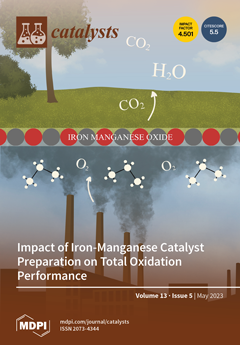Generally, our ecosystem is continuously contaminated as a result of anthropogenic activities that form the basis of our comfort in our routine life. Thus, most scientists are engaged in the development of new technologies that can be used in environmental remediation. Herein, highly
[...] Read more.
Generally, our ecosystem is continuously contaminated as a result of anthropogenic activities that form the basis of our comfort in our routine life. Thus, most scientists are engaged in the development of new technologies that can be used in environmental remediation. Herein, highly calcined binary metal oxide (Er
2O
3@NiO) semiconductor nanocomposite (
NC) was synthesized using a classical wet chemical process with the intention to both detect and degrade the toxic chemicals in an aqueous medium using a novel electrochemical current–potential (
I–V) approach for the first time. Optical, morphological, and structural properties of the newly synthesized semiconductor
NC were also studied in detail using FT-IR, UV/Vis., FESEM-EDS, XPS, BET, EIS, and XRD techniques. Then, a modified glassy carbon electrode (GCE) based on the newly synthesized semiconductor nanocomposite (Er
2O
3@NiO-
NC/Nafion/GCE) as a selective electrochemical sensor was fabricated with the help of 5% ethanolic-Nafion as the conducting polymer binder in order to both detect and electro-hydrolyze toxic chemicals in an aqueous medium. Comparative study showed that this newly developed Er
2O
3@NiO-
NC/Nafion/GCE was found to be very selective against m-tolyl hydrazine (m-Tolyl HDZN) and to have good affinity in the presence of other interfering toxic chemicals. Analytical parameters were also studied in this approach to optimize the newly designed Er
2O
3@NiO-
NC/Nafion/GCE as an efficient and selective m-Tolyl HDZN sensor. Its limit of detection (LOD) at an SNR of 3 was calculated as 0.066 pM over the linear dynamic range (LDR) of our target analyte concentration (0.1 pM–0.1 mM). The limit of quantification (LOQ) and sensitivity were also calculated as 0.22 pM and 14.50 µAµM
−1cm
−2, respectively. m-Tolyl HDZN is among the toxic chemicals in our ecosystem that have lethal effects in living beings. Therefore, this newly designed electrochemical sensor based on semiconductor nanostructure material offers, for the first time, a cost-effective technique, in addition to long-term stability, that can be used as an alternative for efficiently probing other toxic chemicals in real samples.
Full article





